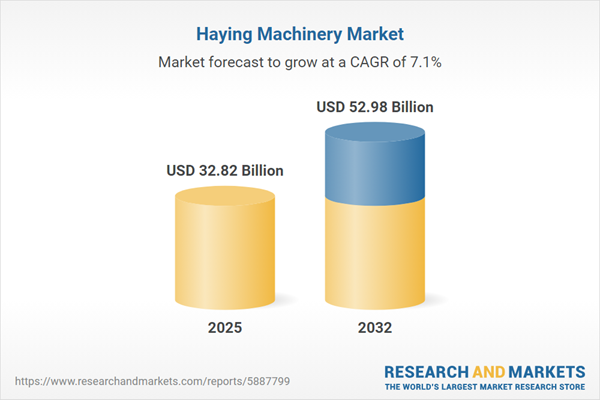Speak directly to the analyst to clarify any post sales queries you may have.
Senior agricultural decision-makers are advancing operational capabilities by modernizing procurement and integrating digital solutions. In this rapidly evolving context, the haying machinery market stands as a focal point for innovation, driving efficiency and competitiveness across farming operations.
Market Snapshot: Haying Machinery Market Size and Growth Opportunity
The haying machinery market is projected to grow from USD 30.62 billion in 2024 to USD 32.82 billion in 2025 and reach USD 52.98 billion by 2032, at a CAGR of 7.09%. This growth is fueled by expanding demand for agricultural outputs, increasing adoption of advanced field machinery, and digital integration across global farming operations. Market leaders are strategically upgrading equipment fleets and supply chains to match emerging operational priorities. For procurement executives, the landscape demands careful evaluation of innovative equipment and sourcing practices to maintain both agility and continuity in dynamic conditions.
Scope & Segmentation: Strategic Perspectives for the Haying Machinery Market
- Product Types: Modern round and square balers, disc and drum mowers, rakes, tedders, and wrapping technologies deliver flexibility and support sustainable agricultural practices.
- End Users: Large farming enterprises prioritize high-output, resilient machinery, while small and mid-sized operations benefit from adaptable, resource-conscious equipment that meets varied production needs.
- Power Output: Solutions are tailored from large-scale, high-horsepower models for enterprise use to compact units designed for farms with smaller acreage or efficiency constraints.
- Applications: Haying equipment supports the full spectrum of crop management activities including raking, conditioning, tedding, cutting, baling, and wrapping for environment-specific needs.
- Drive Types: Self-propelled and tractor PTO-driven systems allow seamless integration into diverse fleets and enable future scalability as operational requirements evolve.
- Technology: Manual, hydraulic, and digital platforms feature automation, GPS integration, remote diagnostics, and enhanced connectivity for high levels of control and oversight.
- Sales Channels: Procurement ranges from OEM distributors to aftermarket suppliers and digital marketplaces, ensuring support continuity and alignment with evolving procurement strategies.
- Key Regions: North America, Europe, Asia-Pacific, Middle East, and Africa exhibit unique regulatory frameworks, supplier networks, and technology adoption profiles influencing market dynamics.
- Industry Participants: The ecosystem comprises established manufacturers and new entrants offering extensive product lines, essential components, and international service capabilities to address shifting market needs.
Key Takeaways: Strategic Insights for Decision-Makers
- Precision agriculture tools streamline farming operations and support greater efficiency throughout the haying cycle, strengthening supply chain coordination.
- Adapting to newer environmental and sustainability regulations influences equipment choices, driving greater focus on resource stewardship and compliance.
- Adoption of automation and connected machinery mitigates skilled labor shortages and improves both worker safety and operational reliability.
- Flexible equipment selection strategies empower organizations to refine resource planning and align machinery with unique operational demands.
- Incorporating diagnostics and predictive maintenance technologies curtails unexpected downtime, safeguarding yields during peak operational windows.
- Diversifying procurement—from digital platforms to traditional channels—enhances supply chain resilience and manages purchasing risk in volatile contexts.
Tariff Impact: Navigating Supply Chain and Cost Volatility
Recent U.S. tariff adjustments add complexity to procurement decisions, requiring buyers to address heightened cost volatility and regulatory change. Leading agricultural firms counter these impacts by re-evaluating geographic sourcing options, standardizing components, and fortifying relationships with priority suppliers to promote supply chain continuity and mitigate risk exposure.
Methodology & Data Sources
This analysis combines direct interviews with industry leadership and comprehensive secondary research, such as examination of regulatory submissions and patent portfolios. Robust tools, including Porter’s Five Forces, ensure that segmentation and insights reflect current competitive realities.
Why This Report Matters
- Provides actionable benchmarks for procurement, operational decision-making, and regulatory compliance, enabling leaders to respond to evolving market demands.
- Equips organizations to strategically manage supply chain challenges, maximize technology adoption, and anticipate future shifts in the haying machinery sector.
- Empowers senior executives to lead digital transformation, cultivate robust supplier relationships, and secure resilient, reliable operations amid sector evolution.
Conclusion
This report supports agricultural executives in enhancing procurement agility and fortifying resilience strategies, ensuring a sustainable competitive advantage as the haying machinery market continues to evolve.
Additional Product Information:
- Purchase of this report includes 1 year online access with quarterly updates.
- This report can be updated on request. Please contact our Customer Experience team using the Ask a Question widget on our website.
Table of Contents
3. Executive Summary
4. Market Overview
7. Cumulative Impact of Artificial Intelligence 2025
Companies Mentioned
The companies profiled in this Haying Machinery market report include:- Deere & Company
- AGCO Corporation
- CNH Industrial N.V.
- CLAAS KGaA mbH
- Kubota Corporation
- Maschinenfabrik Bernard Krone GmbH & Co. KG
- Vermeer Corporation
- KUHN S.A.
- Pöttinger Landtechnik GmbH
- Lely International N.V.
Table Information
| Report Attribute | Details |
|---|---|
| No. of Pages | 181 |
| Published | November 2025 |
| Forecast Period | 2025 - 2032 |
| Estimated Market Value ( USD | $ 32.82 Billion |
| Forecasted Market Value ( USD | $ 52.98 Billion |
| Compound Annual Growth Rate | 7.0% |
| Regions Covered | Global |
| No. of Companies Mentioned | 11 |









